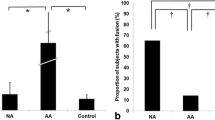Abstract
Using the Octopus G1 program, we investigated the visual fields of amblyopic and healthy contralateral eyes in 21 patients with strabismic amblyopia and 14 patients with anisometropic amblyopia. All subjects had a visual acuity of 0.7-0.06. A central scotoma was detected in 85.7% of the patients with strabismic amblyopia and in 79% of those with anisometropic amblyopia. The mean maximal depth of central scotomas in subjects with strabismic amblyopia was 6.81 ± 4.74 dB (mean ± SD); in those with anisometropic amblyopia, it was 6.64 ± 4.34 dB. This difference was statistically not significant. However, in patients with anisometropic amblyopia, the visual field indices MD (mean defect) and CLV (corrected loss variation) were significantly higher than in those with strabismic amblyopia (P < 0.05 vsP < 0.05); this was predominantly due to additional flat defects that occurred paracentrally and peripherally in subjects with anisometropic amblyopia. In both groups of patients, we found a significant negative correlation between visual acuity, on the one hand, and the maximal depth of the scotomas and the visual field indices (MD and CLV), on the other.
Similar content being viewed by others
References
Aggarwal DP, Verma G (1980) Static perimetry in the study of amblyopic scotomata. Br J Ophthalmol 64:713–716
Aulhorn E (1967) Die gegenseitige Beeinflussung abbildungsgleicher Netzhautstellen bei normalem und gestörtem Binokularsehen. Doc Ophthalmol 23:26–61
Bebie H (1985) Computerized techniques of visual field comparison. In: Drance SM, Anderson DR (eds) Automated perimetry in glaucoma: a practical guide. Grune & Stratton, Orlando London, pp 147–160
Flammer J (1986) The concept of visual field indices. Graefe's Arch Clin Exp Ophthalmol 224:389–392
Flammer J (1987) The Octopus glaucoma G-1 program. Glaucoma 9:67–72
Flammer J, Drance SM, Augustiny L, Funkhouser A (1985) Quantification of glaucomatous visual field defects with automated perimetry. Invest Ophthalmol Vis Sci 26: 176–181
Flynn JT (1967) Spatial summation in amblyopia. Arch Ophthalmol 78:470–474
Global Analysis Program G-1 (1986) Interzeag AG, Schlieren, Switzerland
Harms H (1937) Ort und Wesen der Bildhemmung bei Schielenden. Graefe's Arch Clin Exp Ophthalmol 138:149–210
Hess RF, Pointer JS (1985) Differences in the neural basis of human amblyopia: the distribution of the anomaly across the visual field. Vision Res 25:1577–1594
Hess RF, Campbell FW, Zimmern R (1980) Differences in the neural basis of human amblyopias: the effect of mean luminance. Vision Res 20:295–305
Johnson CA, Keltner JL, Balestrery FG (1979) Acuity profile perimetry. Description of technique and preliminary clinical trials. Arch Ophthalmol 97:684–689
Lang J (1978) Die Skotome im binokularen Gesichtsfeld bei hochgradiger Amblyopie und bei Mikrostrabismus. Klin Monatsbl Augenheilkd 173:470–476
Leuenberger AE, Schaetti M, Fischer AM (1986) Untersuchungen mit dem automatischen Perimeter Octopus bei Amblyopien. Z Prakt Augenheilkd 7:280–282
Levi DM, Klein S (1982) Differences in vernier discrimination for gratings between strabismic and anisometropic amblyopes. Invest Ophthalmol Vis Sci 23:398–407
Mackensen G (1959) Monoculare and binoculare statische Perimetrie zur Untersuchung der Hemmungsvorgange beim Schielen. Graefe's Arch Clin Exp Ophthalmol 160:573–587
Meur G (1964) Étude des sommations spatiales rétiniennes dans les amblyopies fonctionnelles. Bull Soc Beige Ophtalmol 137:377–385
Miller EF (1955) Investigation of the nature and cause of impaired acuity in amblyopia. Am J Optom 32:10–29
Noorden GK von (1985) Burian-von Noorden's binocular vision and ocular motility. Theory and management of strabismus, 3rd edn. Mosby, St Louis, pp 213–214
Octopus 2000R Manual (1983) Interzeag AG, Schlieren, Switzerland
Octopus 500/500E Manual (1985) Interzeag AG, Schlieren, Switzerland
Parks M (1969) The monofixation syndrome. Trans Am Ophthalmol Soc 67:609–657
Pratt-Johnson JA (1969) Sensory phenomena associated with suppression. Br Orthopt J 26: 15
Sireteanu R, Fronius M (1981) Naso-temporal asymmetries in human amblyopia: consequence of long-term interocular suppression. Vision Res 21:1055–1063
Sireteanu R, Fronius M, Singer W (1981) Binocular interaction in the peripheral visual field of humans with strabismic and anisometropic amblyopia. Vision Res 21:1065–1074
Wald G (1965) Discussion of paper by Harms H, Stellungnahme zur Arbeit: Ort und Wesen der Bildhemmung bei Schielenden. Ber Dtsch Ophthalmol Ges 66:212–213
Wald G, Burian HM (1944) The dissociation of form vision and light perception in strabismic amblyopia. Am J Ophthalmol 27:950–963
Whalen WR (1985) BASIC software: examination programs and printout of results. In: Whalen WR, Spaeth GL (eds) Computerized visual fields. What they are and how to use them. Slack Incorporated, Thorofare, p 63
Author information
Authors and Affiliations
Rights and permissions
About this article
Cite this article
Philipp, W., Mayer, W. Investigation of visual field defects in strabismic and anisometropic amblyopes with the Octopus Program G1. Graefe's Arch Clin Exp Ophthalmol 227, 448–454 (1989). https://doi.org/10.1007/BF02172897
Received:
Accepted:
Issue Date:
DOI: https://doi.org/10.1007/BF02172897




